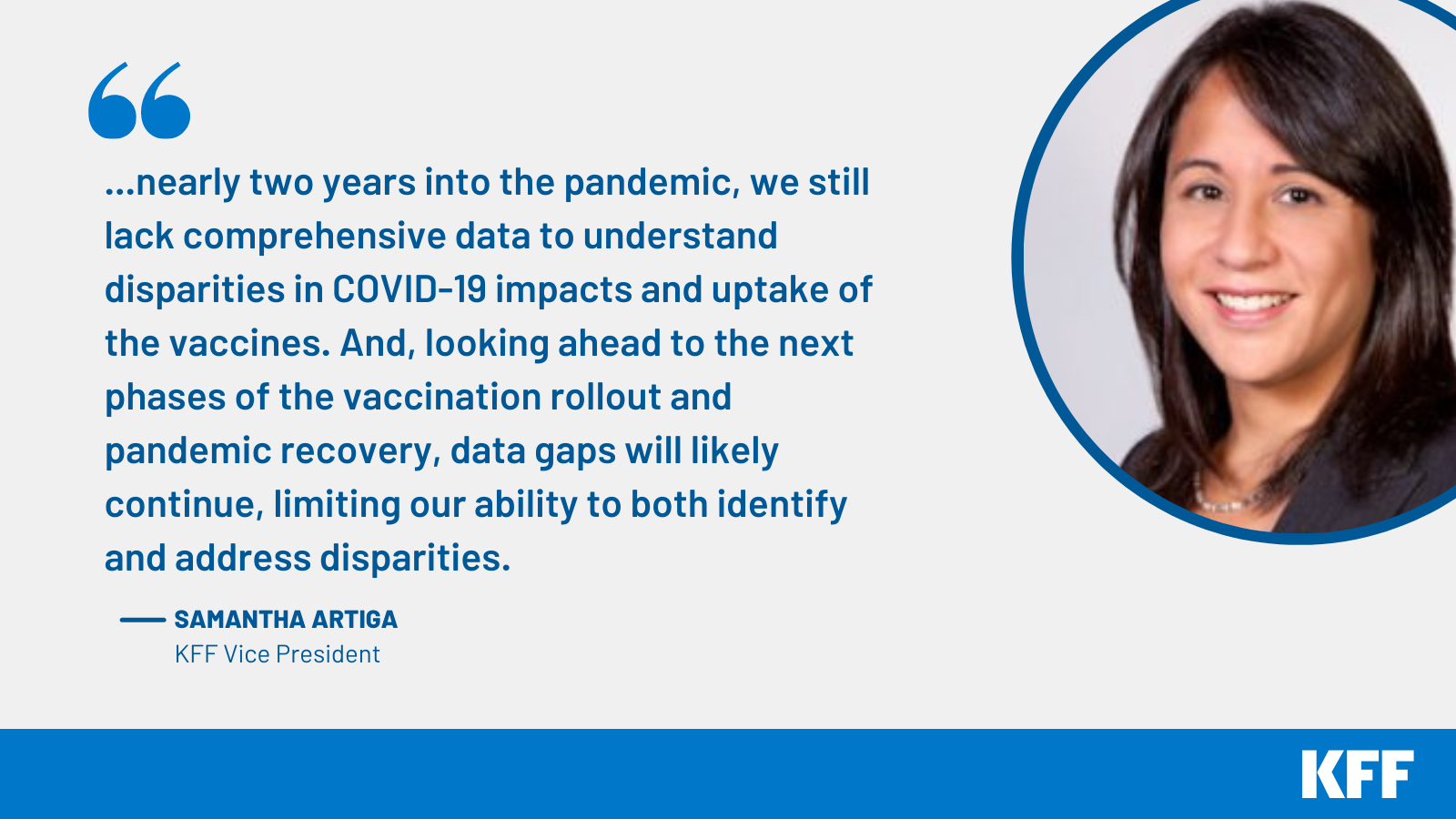One hallmark of the COVID-19 pandemic has been its disproportionate impact on people of color. Although recent trends point to a narrowing in racial disparities in COVID-19 cases and deaths, overall, people of color have borne the brunt of the pandemic—from higher rates of infection, illness, and death to negative mental health, social, and economic impacts. The disparate impacts of the pandemic have given rise to wide recognition of and increased calls to address longstanding racial disparities in health and health care. Yet, nearly two years into the pandemic, we still lack comprehensive data to understand disparities in COVID-19 impacts and uptake of the vaccines. Looking ahead to the next phases of the vaccination rollout and pandemic recovery, data gaps will likely continue, limiting our ability to identify and address disparities.
Data are a cornerstone for efforts to address disparities and advance health equity. Data are essential for identifying where disparities exist, directing efforts and resources to address disparities as they are identified, measuring progress toward achieving greater equity, and establishing accountability for achieving progress. Without adequate data, inequities remain unseen and unaddressed.
A recurrent issue over the course of the pandemic has been a lack of data regarding racial disparities. Early in the pandemic, the federal government and many states did not report COVID-19 cases, hospitalizations, and deaths by race or ethnicity. Over time, reporting of these data has increased, but the data still have gaps and limitations. There was more racial/ethnic data reported when the COVID-19 vaccination rollout began, but these data also have deficiencies. The Centers for Disease Control and Prevention (CDC) reports race/ethnicity of people vaccinated at the federal level, but race/ethnicity data is missing for nearly 40% of people vaccinated. Moreover, CDC is not reporting vaccinations by race/ethnicity at the state level, limiting understanding of how disparities may vary across the country. In the absence of this reporting, KFF has conducted an ongoing analysis of state-reported data on vaccinations by race/ethnicity. However, this effort is challenged by inconsistencies in how states report their data. Unlike federally reported data, which is standardized, states vary in the racial/ethnic classifications they use, their units of measure, and their frequency of reporting, among other factors.
Data that will be key for identifying and addressing disparities in the next phases of the vaccination rollout and recovery effort are not currently available. As the next phases of the vaccination rollout occur, it will be important to understand who is and is not getting booster shots and, when younger children become eligible, whether they face the same disparities in vaccination uptake that affected adults. As more people are vaccinated, we will also want to know if some groups are at increased risk for breakthrough infections and illness. Insight into testing patterns will also be important, particularly with many children having returned to in-person school and growing numbers of people returning to in-person work and social activities. However, we currently lack data to answer many of these questions. For example, there is very limited data on vaccinations by race/ethnicity broken out by age, meaning that we do not know if there are racial disparities in the uptake of vaccinations among adolescents who are already eligible and will not know if there are disparities among younger children when they become eligible without improved reporting. Data are not available to identify who received which type of COVID-19 vaccine, which likely will be important for understanding who should receive a booster dose. Moreover, at this time, CDC is not reporting race/ethnicity of booster dose recipients, and only a handful of states are reporting these data. Beyond vaccination data gaps, others have highlighted the paucity of data to identify whether some groups are at higher risk for breakthrough infections and illness. Additionally, there still are major gaps in data on testing, including whether testing rates vary by race/ethnicity, whether some groups face greater barriers to accessing testing than others (e.g., cost, distance traveled, etc.), if times to receive test results vary across groups, and if there is variation in the types of tests (e.g., at home, rapid, PCR) people use.
Increasing availability of high-quality, comprehensive data disaggregated by race/ethnicity is a prerequisite for efforts to advance health equity, not only related to COVID-19 but in health and health care more broadly. Prioritizing data collection and reporting to identify and address disparities by race/ethnicity and other factors is a key first step to addressing data gaps and limitations. As part of this work, focused efforts to expand data available for smaller groups, such as American Indian and Alaska Native and Native Hawaiian and Other Pacific Islander people, as well as subpopulations of the broader racial/ethnic categories will be important for a complete understanding of individuals’ experiences. Increased standardization of racial/ethnic data would also aid in analyzing and interpreting data. The federal government has minimum standards for reporting race/ethnicity data. However, these standards were last revised in 1997 and may not fully reflect the diversity of today’s population. Moreover, the standards do not apply to reporting by states, localities, or private entities. Encouraging, incentivizing, or requiring minimum standards across more entities would provide more consistent data. In some cases, improving data may require modernizing data collection and reporting systems and structures to allow for more disaggregated data reporting. Conducting outreach to providers and other entities that collect data as well as directly to individuals reporting data about the importance and value of demographic data may also help to improve the completeness and accuracy of data over time.

